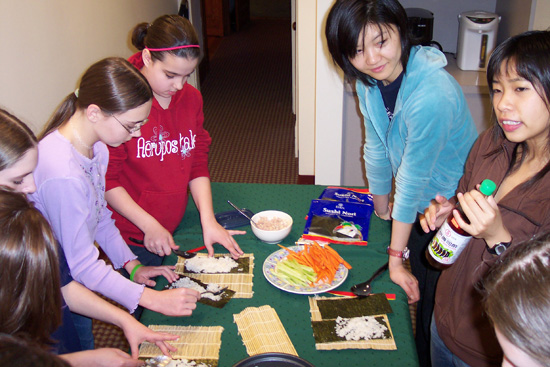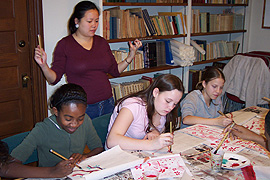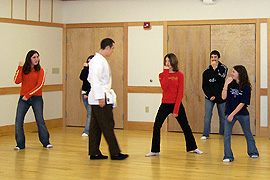Outreach Program Gives Local Students a Taste of East Asian Culture
 |
 Pictured at top, right, Yashan Zhou ’09 and Mo Sarakun ’07 teach seventh graders from Woodrow Wilson Junior High School how to make their own sushi rolls. Pictured at top, right, Yashan Zhou ’09 and Mo Sarakun ’07 teach seventh graders from Woodrow Wilson Junior High School how to make their own sushi rolls.
Pictured at left, Ada Fung ’06 teaches the students how to paint cherry blossoms on rice paper. Pictured below, Alex Weber ’06 teaches martial arts and the history of the shaolin. |
| Posted 03/01/06 |
| Seventh-grader Liam Wolfram had tried sushi at Japanese restaurants, but hes never attempted to make his own. Last month, Liam did just that as he and 25 of his classmates from Woodrow Wilson Middle School in Middletown experienced a taste of East Asian Culture at Wesleyan by preparing their own sushi rolls.
It only took about a minute to make, and its really good, Liam says, chomping off a bite of his seaweed wrap, teeming with tuna, cucumber and carrot. The rice sticks to the top of your mouth, though. The student-run program is offered Friday mornings throughout the academic year and reaches about 300 students each year. Wesleyan students plan and run the activity workshops for each visiting class. What do you know about Japan? asks the programs co-coordinator Mo Sarakun 07. Its made up of islands, one student answers. They have a lot of noodles there, another replies. Sarakun, a China native who studies Japanese culture at Wesleyan, taught the sushi session and talked to the students about Japan. Afterwards, the seventh graders moved to another room to learn about painting on rice paper. Program co-coordinator Ada Fung 06 taught painting techniques and the students participated and went back to school with their own paintings of cherry blossoms. Fung, who has worked as a coordinator for three years, says she enjoys working with area children because of their eagerness to learn something new. Curiosity and open-mindedness are the two most important things a student can bring when they come to participate in the program because theyll get a lot more out of it, she says. It’s a crash course in East Asian culture, but if we can plant the seed, just inspire and encourage them to keep learning about other cultures and countries, I think we will have achieved our purpose. The Outreach Programs coordinators tailor each session to the incoming classs age level, ranging from preschool through high school. Visiting classes average about 25 students in size, and are split into three smaller groups which rotate among the activity sessions. This way, each student has the opportunity to participate in three different activities. Other sessions offered include Writing and Language, Food in East Asia, Martial Arts, Japanese Tea Ceremony, East Asian Music, Traditional Clothing, Kamishibai Story-telling and Origami. Po-wei Weng, a graduate student in the Music Department, also has taught segments on Peking Opera, introducing the music, techniques, gongs and symbols. The sessions may include visits in the Freeman Centers Japanese-style tatami room and garden, a kitchen to prepare Chinese and Japanese meals, and a gallery with changing exhibitions of East Asian art. Wesleyan students benefit from teaching the sessions, explains Stephen Angle, chair of the East Asian Studies Program, director of the Freeman Center for East Asian Studies and associate professor of East Asian Studies and philosophy. The Outreach Program gives our own Wesleyan students the opportunity to practice communicating their understanding of East Asian culture to others, Angle says. At the same time, our students are serving a younger generation of students in the community surrounding Wesleyan. This is the second year Kim Fentress, a teacher at Woodrow Wilson school, brought her geography students to the Wesleyan program. Were just beginning to study East Asian culture, and the program here at Wesleyan really ties in with that were learning, Fentress says. Its wonderful we have Wesleyan right here in Middletown. For more information on the Outreach Program, contact program coordinator Shirley Lawrence at 860-685-2330 or e-mail slawrence@wesleyan.edu, or Ada Fung at afung@wesleyan.edu. |
| By Olivia Drake, Wesleyan Connection editor |


